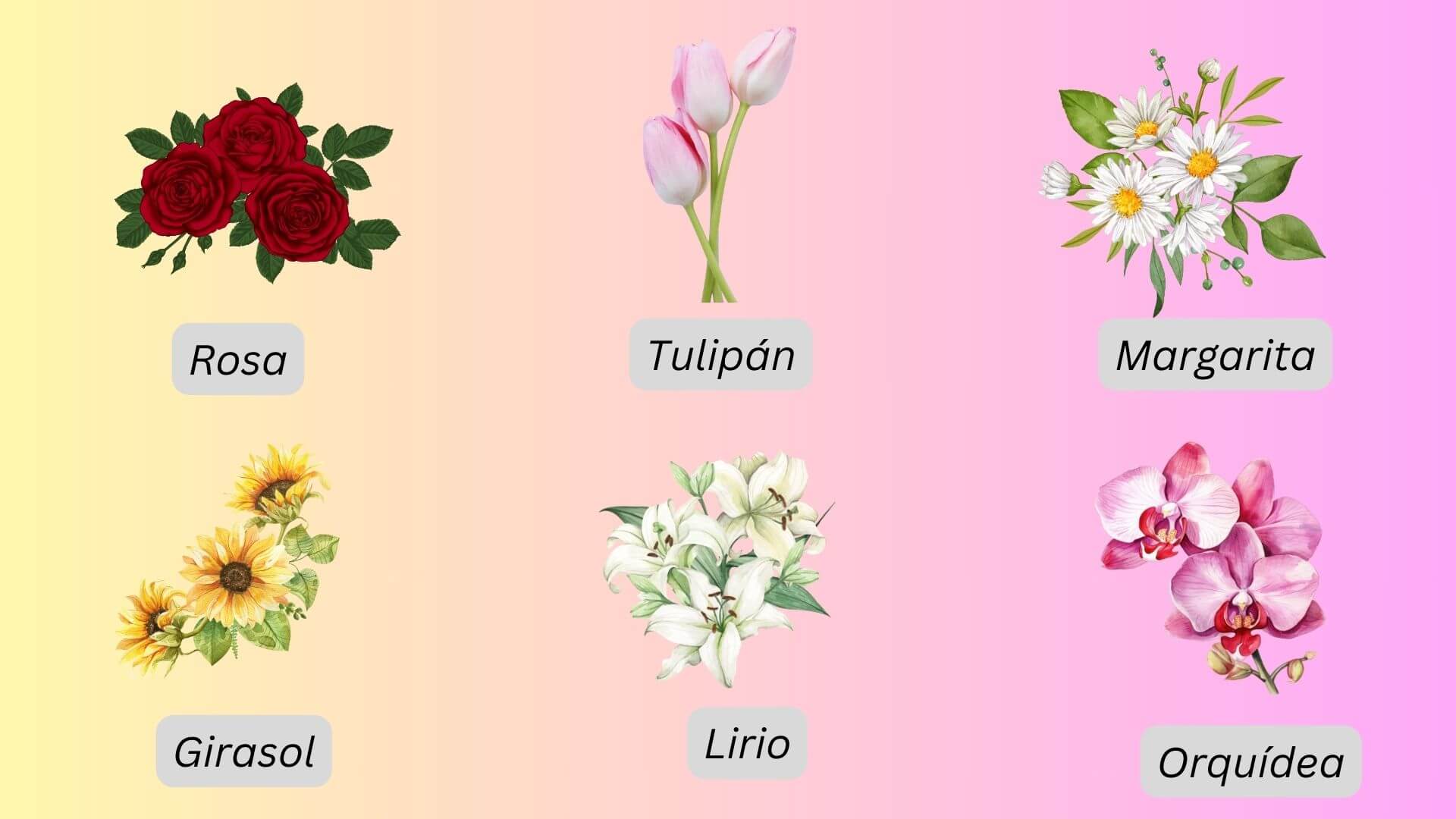Diving into Spanish flower names is like opening the door to Spanish-speaking places’ colourful and diverse cultures. Each name tells a story, showing us the history, local plants, and what people have valued for generations. It’s more than just words—it’s about connecting with the rhythms of nature and society.
When we study these names, we do more than just build our vocabulary. We also get a deeper look at how different communities see and cherish their natural world. These names are a big part of people’s cultural identity.
Discover 150+ Flowers in Spanish

Exploring over 150 flower names in Spanish opens up a world of language and culture.
Let’s explore some of the most famous Spanish flower names, explore the national flowers of Spanish-speaking countries, and see how these flowers are used in traditional medicine.
| Spanish | English |
| Rosa | Rose |
| Tulipán | Tulip |
| Margarita | Daisy |
| Girasol | Sunflower |
| Lirio | Lily |
| Clavel | Carnation |
| Orquídea | Orchid |
| Narciso | Daffodil |
| Violeta | Violet |
| Peonía | Peony |
| Amapola | Poppy |
| Jazmín | Jasmine |
| Hortensia | Hydrangea |
| Iris | Iris |
| Azucena | Lily of the valley |
| Gladiolo | Gladiolus |
| Geranio | Geranium |
| Camelia | Camellia |
| Begonia | Begonia |
| Fresia | Freesia |
| Gardenia | Gardenia |
| Heliotropo | Heliotrope |
| Jacinto | Hyacinth |
| Lavanda | Lavender |
| Magnolia | Magnolia |
| Mimosa | Mimosa |
| Nenúfar | Water lily |
| Petunia | Petunia |
| Rododendro | Rhododendron |
| Verbena | Verbena |
| Zinnia | Zinnia |
| Azalea | Azalea |
| Caléndula | Marigold |
| Cineraria | Cineraria |
| Dalia | Dahlia |
| Ébano | Ebony |
| Fucsia | Fuchsia |
| Glicinia | Wisteria |
| Helecho | Fern |
| Impatiens | Impatiens |
| Lantana | Lantana |
| Mirto | Myrtle |
| Nardo | Tuberose |
| Olivo | Olive |
| Papiro | Papyrus |
| Quejigo | Kermes oak |
| Retama | Broom |
| Salvia | Sage |
| Tamarindo | Tamarind |
| Uña de gato | Cat’s claw |
| Vinca | Periwinkle |
| Yucca | Yucca |
| Zanahoria silvestre | Wild carrot |
| Abejón | Borage |
| Belladona | Belladonna |
| Cactus | Cactus |
| Diente de león | Dandelion |
| Espuela de caballero | Delphinium |
| Flor de lis | Iris |
| Gisante de olor | Sweet pea |
| Hiedra | Ivy |
| Jacaranda | Jacaranda |
| Kalanchoe | Kalanchoe |
| Laurel | Laurel |
| Malva | Mallow |
| Nogal | Walnut |
| Orquídea negra | Black orchid |
| Pasionaria | Passion flower |
| Quisqualis | Rangoon creeper |
| Romero | Rosemary |
| Sándalo | Sandalwood |
| Tabaco | Tobacco |
| Ulmaria | Meadowsweet |
| Verbascum | Mullein |
| Xerochrysum | Everlasting |
| Ylang-ylang | Ylang-ylang |
| Zarzamora | Blackberry |
| Alhelí | Stock |
| Bambú | Bamboo |
| Ciclamen | Cyclamen |
| Espino | Hawthorn |
| Forsitia | Forsythia |
| Guisante | Pea |
| Hibisco | Hibiscus |
| Incienso | Frankincense |
| Junco | Rush |
| Kiwi | Kiwi |
| Lila | Lilac |
| Madreselva | Honeysuckle |
| Ñame | Yam |
| Olmo | Elm |
| Palo de rosa | Rosewood |
| Quinoa | Quinoa |
| Ruibarbo | Rhubarb |
| Sagu | Sago |
| Tilo | Linden |
| Ulex | Gorse |
| Vinagre | Sorrel |
| Xantina | Xanthium |
| Yerba mate | Mate |
| Zarzaparrilla | Sarsaparilla |
| Almendro | Almond |
| Buganvilla | Bougainvillea |
| Ciprés | Cypress |
| Duquesa | Dutchman’s pipe |
| Escaramujo | Rosehip |
| Frambuesa | Raspberry |
| Grosella | Gooseberry |
| Higo | Fig |
| Inmortal | Immortelle |
| Juncia | Rush |
| Kikuyo | Kikuyu grass |
| Limonero | Lemon |
| Menta | Mint |
| Níspero | Medlar |
| Olivo silvestre | Wild olive |
| Pino | Pine |
| Quercus | Oak |
| Ruibarbo silvestre | Wild rhubarb |
| Saúco | Elder |
| Tejo | Yew |
| Uva | Grape |
| Vinca rosa | Pink periwinkle |
| Xanthosoma | Elephant ear |
| Yedra | Ivy |
| Zanahoria | Carrot |
| Abeto | Fir |
| Brote | Sprout |
| Cicuta | Hemlock |
| Dátil | Date |
| Escorzonera | Scorzonera |
| Fresia silvestre | Wild freesia |
| Granado | Pomegranate |
| Hiedra venenosa | Poison ivy |
| Índigo | Indigo |
| Jengibre | Ginger |
| Kiwi silvestre | Wild kiwi |
| Limón | Lemon |
| Mostaza | Mustard |
| Naranjo | Orange |
| Olmo montañoso | Mountain elm |
| Pimienta | Pepper |
| Quinoa silvestre | Wild quinoa |
| Romero silvestre | Wild rosemary |
| Sáuco montañoso | Mountain elder |
| Tomillo | Thyme |
| Uva silvestre | Wild grape |
| Vinca silvestre | Wild periwinkle |
| Xerófito | Xerophyte |
| Yerbabuena | Spearmint |
| Zumo de uva | Grape juice |
Most Popular Flower Names in Spanish
Exploring Spanish flower culture shows us over 150 popular flower names, each unique in its beauty and meaning. Some top favourites include the ‘rosa’ (rose), famous for its romantic vibes, and the bright ‘girasol’ (sunflower), which stands for adoration and loyalty.
| Spanish Name | English Name |
| Rosa | Rose |
| Tulipán | Tulip |
| Margarita | Daisy |
| Girasol | Sunflower |
| Lirio | Lily |
| Clavel | Carnation |
| Orquídea | Orchid |
| Narciso | Daffodil |
| Violeta | Violet |
| Peonía | Peony |
| Amapola | Poppy |
| Jazmín | Jasmine |
| Hortensia | Hydrangea |
| Iris | Iris |
| Azucena | Lily of the valley |
National Flowers in Spanish
In Spanish-speaking countries, national flowers are more than just pretty plants; they symbolise each nation’s culture and history. These flowers often hold deep meanings linked to a country’s past, legends, and sometimes religious practices. Generally, a country chooses a native flower that resonates with its people’s values and stories.
| Country | National Flower | Country |
| Argentina | Ceibo (Erythrina crista-galli) | Argentina |
| Bolivia | Kantuta (Cantua buxifolia) & Patujú (Heliconia rostrata) | Bolivia |
| Chile | Copihue (Lapageria rosea) | Chile |
| Colombia | Orchid (Cattleya trianae) | Colombia |
| Costa Rica | Guaria Morada (Guarianthe skinneri) | Costa Rica |
| Cuba | Mariposa (Hedychium coronarium) | Cuba |
| Dominican Republic | Bayahibe Rose (Pereskia quisqueyana) | Dominican Republic |
| Ecuador | Orchid (Chuquiraga jussieui) | Ecuador |
| El Salvador | Flor de Izote (Yucca gigantea) | El Salvador |
| Guatemala | White Nun Orchid (Lycaste virginalis) | Guatemala |
Medicinal Flowers in Spanish
Exploring medicinal flowers in Spanish can boost your knowledge of their health benefits and traditional uses. Knowing these names isn’t just about learning botany; it’s about connecting with a longstanding tradition of natural medicine in Spanish-speaking regions.
| Spanish Name | English Name |
| Manzanilla | Chamomile |
| Caléndula | Calendula |
| Lavanda | Lavender |
| Milenrama | Yarrow |
| Equinácea | Echinacea |
| Verbena | Verbena |
| Malva | Mallow |
| Saúco | Elderflower |
| Arnica | Arnica |
| Hipérico | St. John’s Wort |
| Belladona | Belladonna |
| Pasiflora | Passionflower |
| Borraja | Borage |
| Tila | Linden flower |
| Cardo mariano | Milk thistle |
Conclusion
To sum up, learning over 150 Spanish flower names boosts your language skills and deepens your appreciation for Spanish-speaking areas’ culture and plant life. Knowing about flowers like ‘Manzanilla’ and ‘Caléndula’, used in traditional medicine, shows these plants’ importance. This knowledge helps connect anyone learning the language or interested in plants with the rich floral traditions of the Spanish-speaking world.

